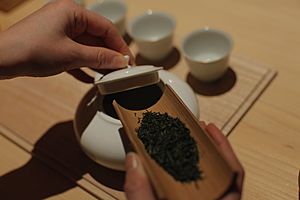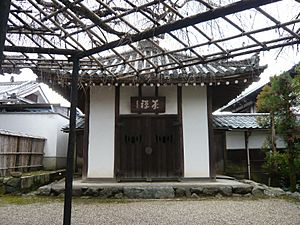Senchadō facts for kids
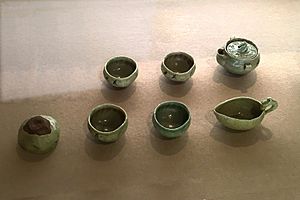
Senchadō ("way of sencha" (煎茶道)) is a special Japanese way of making and drinking tea. It's like a cousin to the more famous chadō ("way of tea"). This tradition focuses on preparing and enjoying sencha green tea, especially a very high-quality type called gyokuro.
What is Senchadō?
Senchadō is a Japanese tea ceremony that uses sencha green tea. Unlike matcha tea, which is powdered, sencha is made from small tea leaves.
This tea ceremony has a special set of rules for how to prepare, serve, and enjoy the tea. It's similar to the Chinese Gongfu tea ceremony, which also has a very specific way of making tea.
History of Senchadō
The story of Senchadō began in Japan around the late 1600s, during the Edo period. At that time, Chinese traders visiting the city of Nagasaki showed the Japanese how they brewed and drank tea in China. This style of Chinese tea culture became popular in Japan during the 1700s.
It was especially liked by educated people and merchants. They enjoyed meeting friends in a more relaxed way than the very formal chanoyu. These meetings were a chance to appreciate art, especially paintings and old books. People would often share meals and admire the host's collections. These collections usually included items from China or Japanese items made in the Chinese style, called karamono.
In spring 2020, the Aichi Prefectural Ceramic Museum worked with Meiji-mura to hold a big sencha exhibition. It was about Kimura Teizo, a famous art collector from Nagoya. He started collecting art when he was only 25 years old. He became a great supporter of artists. His collection of 3,307 items was given to the Aichi Prefectural Museum of Art. It included modern art, Edo period paintings, tea pottery, and other historical items.
Tools for Senchadō
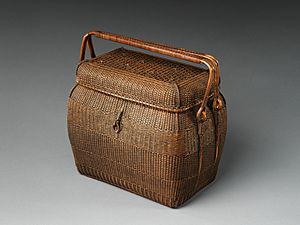
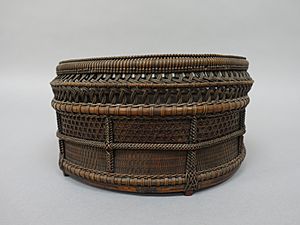
To perform Senchadō, you need special tools. Some of these tools are also used in matcha tea ceremonies. Different schools of Senchadō might use different names for the same item. They also might not use every item on this list.
Here are some of the important tools:
- Mat (茶具褥): This is placed in the room to show where the tea ceremony will happen.
- Stove (凉爐): Used to heat the water.
- Stove equipment:
- Furnace fan (爐扇)
- Feather broom (羽帚)
- Fire chopsticks (火箸 Hibashi)
- Tank holder (罐座 Kama-za)
- Charcoal (烏府 Karasu-fu)
- Fire screen (爐屏 Robyō): A screen placed near the stove.
- Tea kettle (保宇夫良): A pottery kettle for heating water.
- Water pourer (水注 Mizu chū): Used to pour water.
- Waste water bowl (建水 Kensui): Where used water is poured.
- Tea container (茶心壺 Chaire): Holds the sencha tea leaves.
- Tea scoop (仙媒): Used to scoop tea leaves.
- Tea cloth (茶巾 Chakin): A small cloth to wipe the tea bowl.
- Cloth tube (巾筒 Kintō): A small holder for the tea cloth.
- Small teapot (急須 Kyūsu): A special teapot for brewing sencha.
- Smaller kyusu (泡瓶): A small teapot without a handle.
- Water cooler (湯冷): A small dish to cool hot water.
- Coasters (瓶床): For placing utensils, made of wood, metal, or lacquer.
- Tea bowl (茶碗 Chawan): A small cup, usually made of white porcelain.
- Bowl tube (碗筒 Wantō): A container, often woven bamboo, to store the small tea cups.
- Tea cup coasters (茶托 Chataku): Made of metal, for the tea cups.
- Tray (盆): A tray for carrying items.
- Censer (香爐 Kōro): For burning incense.
- Incense tube (綫香筒): Holds the incense sticks.
- Tea banner (茶旗): A decorative banner.
- Curtain (帳): A curtain for the room.
- Tea container (茶櫃 Chaki): Another type of tea container.
- Utensils box (提籃): A basket or box for carrying tools.
- Tea board (茶盤): A board used during the ceremony.
- Tea cabinet (茶局): A small cabinet for tea items.
- Stand (棚): A display stand.


